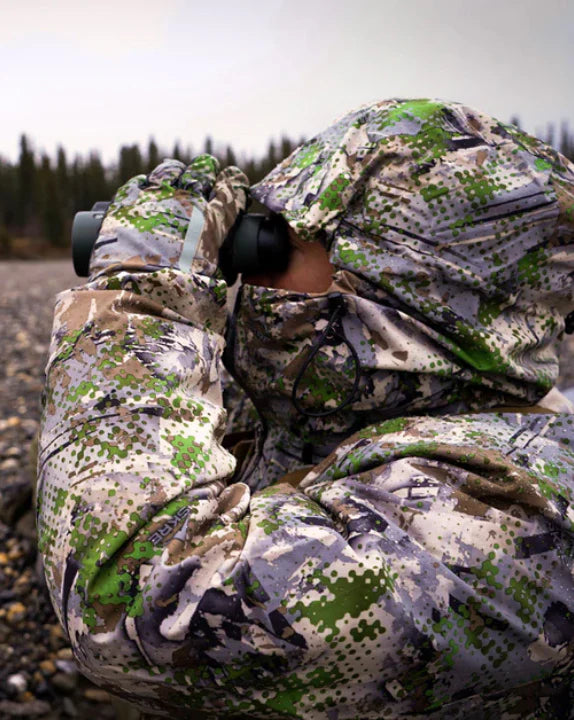Le guide ultime pour choisir le bon équipement de pluie de chasse
Oct 04, 2024
La chasse est autant une lutte contre les éléments qu'une épreuve de compétences, de stratégie et de patience. En pleine nature, exposé aux forces imprévisibles de la nature, un équipement adapté peut faire toute la différence. Pluie, vent et froid peuvent rapidement transformer une chasse bien planifiée en une expérience pénible si vous n'êtes pas équipé des vêtements adéquats. C'est là que les vêtements de pluie pour la chasse entrent en jeu.
Investir dans des vêtements de pluie de chasse de qualité ne se limite pas à rester au sec : il s'agit d'assurer votre confort, votre sécurité et vos performances sur le terrain. Ce contenu éducatif explore l'importance de bien choisir ses vêtements de pluie pour la chasse, en se concentrant sur quatre caractéristiques clés : imperméabilité, respirabilité, durabilité et réduction du bruit. À la fin de ce guide complet, vous aurez les connaissances nécessaires pour choisir en toute connaissance de cause les meilleurs vêtements de pluie pour vos aventures de chasse.
Découvrez pourquoi les vêtements de pluie sont essentiels
SKRE Gear® propose le meilleur équipement pour Pour des chasses réussies. Consultez notre dernier article de blog expliquant l'importance des vêtements de pluie pour la chasse.
CDécouvrez notre dernier article de blog
L'importance de l'imperméabilité dans les vêtements de pluie de chasse
L'imperméabilité est le facteur le plus important à prendre en compte lors du choix d'un équipement de pluie pour la chasse. La chasse se déroule souvent dans des environnements imprévisibles où les conditions météorologiques peuvent changer rapidement. Une journée ensoleillée peut vite se transformer en journée pluvieuse, et sans équipement imperméable, vous vous retrouverez trempé, gelé et inconfortable. Explorons la science derrière l'imperméabilité et son importance pour la chasse.
Comprendre la différence entre l'imperméabilisation et la résistance à l'eau
Tout d'abord, il est essentiel de comprendre la différence entre un équipement « imperméable » et « résistant à l'eau ». De nombreux chasseurs croient à tort que ces termes sont interchangeables, alors qu'ils offrent des niveaux de protection très différents.
- Équipement imperméableLes tissus imperméables sont conçus pour empêcher complètement l'eau de pénétrer. Les vêtements de pluie de haute qualité sont dotés de membranes imperméables telles que GORE-TEX, eVent ou d'autres tissus exclusifs qui créent une barrière protectrice. Ces membranes sont constituées de pores microscopiques, trop petits pour laisser passer les gouttelettes d'eau, mais suffisamment grands pour permettre à la vapeur d'eau (transpiration) de s'échapper.
- Équipement résistant à l'eauLes matériaux imperméables, quant à eux, peuvent repousser la pluie légère ou l'humidité, mais finiront par pénétrer sous une forte pluie. Bien qu'ils puissent convenir à de courtes expositions à l'humidité, ils ne vous protégeront pas en cas de pluie prolongée ou de fortes averses.

Pourquoi c'est important: Lorsque vous êtes sur le terrain pendant des heures, voire des jours, vous avez besoin d'un équipement imperméable fiable, capable de résister à une exposition prolongée à l'humidité. Que vous chassiez en forêt dense, dans une zone marécageuse ou en haute altitude avec une météo imprévisible, un équipement de pluie imperméable vous permet de rester au sec et concentré sur votre chasse.
Explication des indices d'étanchéité
Tous les équipements imperméables ne se valent pas. Les fabricants utilisent des indices d'imperméabilité, mesurés en millimètres (mm), pour indiquer le niveau de résistance à l'eau de leurs tissus. Plus l'indice est élevé, plus le tissu est imperméable. Voici un aperçu des indices d'imperméabilité courants :
- 5 000 mm – 10 000 mm:Convient aux pluies légères à modérées, mais peut ne pas résister aux pluies prolongées ou fortes.
- 10 000 mm – 15 000 mm:Idéal pour les pluies modérées à fortes et convient à la plupart des conditions de chasse.
- 15 000 mm – 20 000 mm:Conçu pour les fortes pluies et les conditions météorologiques extrêmes, offrant une protection maximale.
- 20 000 mm+:Le plus haut niveau d'imperméabilité, généralement utilisé dans les équipements d'alpinisme et les environnements difficiles.
Choisir la bonne cote pour la chasse:Pour la plupart des conditions de chasse, un équipement avec un indice d'imperméabilité compris entre 10 000 et 15 000 mm devrait suffire. Cependant, si vous chassez dans des conditions météorologiques extrêmes ou humides, envisagez un équipement avec un indice d'imperméabilité de 20 000 mm ou plus pour une protection maximale.
Revêtements DWR et étanchéité des coutures
Outre les membranes imperméables, de nombreux pantalons et vestes de chasse sont traités avec un revêtement déperlant durable (DWR). Ce revêtement permet à l'eau de perler et de glisser sur la surface du tissu, l'empêchant ainsi de saturer le matériau.
- Revêtement DWRBien que le traitement DWR favorise l'écoulement de l'eau, il s'estompe avec le temps, surtout après des utilisations et des lavages répétés. Vous pouvez prolonger la durée de vie de vos vêtements de pluie en appliquant régulièrement un traitement DWR.
- Scellage des couturesMême le tissu le plus imperméable ne vous protégera pas si l'eau pénètre par les coutures. Un équipement de chasse de qualité doit avoir des coutures entièrement scellées ou soudées pour empêcher l'eau de s'infiltrer. Vérifiez toujours cette caractéristique lorsque vous choisissez un équipement imperméable.
Découvrez pourquoi les vêtements de pluie sont essentiels
SKRE Gear® propose le meilleur équipement pour Pour des chasses réussies de la saison. Consultez notre dernier article de blog expliquant l'importance des vêtements de pluie pour la chasse.
Consultez notre dernier article de blog
Le rôle de la respirabilité dans les vêtements de pluie de chasse
Si l'imperméabilité est essentielle, la respirabilité l'est tout autant. Sans respirabilité, les vêtements de pluie imperméables peuvent emprisonner la chaleur et l'humidité, provoquant une transpiration excessive. Cette accumulation d'humidité entraîne inconfort, baisse de la température corporelle et même risque d'hypothermie par temps froid. Découvrons pourquoi la respirabilité est essentielle et comment identifier des vêtements de pluie respirants pour la chasse.
La science de la respirabilité
Les tissus respirants sont conçus pour permettre à la vapeur d'eau (transpiration) de s'échapper tout en empêchant la pluie et l'humidité de pénétrer. Ce résultat est obtenu grâce à de minuscules pores dans la membrane du tissu, suffisamment petits pour bloquer les gouttes d'eau, mais suffisamment grands pour laisser passer la vapeur.
Pourquoi c'est important:La chasse implique souvent des périodes d'intense activité suivies de moments d'immobilité. Que vous soyez en randonnée vers un endroit isolé, à l'affût ou que vous installiez votre affût, votre corps produit de la chaleur et de la transpiration. Sans respirabilité, la transpiration s'accumule, provoquant une surchauffe et un inconfort. À terme, la transpiration accumulée peut également entraîner de l'humidité et des frissons lorsque votre niveau d'activité diminue.
Explication des indices de respirabilité
Tout comme l'imperméabilité, la respirabilité est évaluée par la quantité de vapeur d'eau qui peut traverser le tissu. Cette valeur est mesurée en grammes par mètre carré par 24 heures (g/m²/24 h), également appelé MVTR (taux de transmission de la vapeur d'eau). Plus le MVTR est élevé, plus le tissu est respirant. Voici un aperçu des indices de respirabilité courants :
- 5 000 g/m²/24 h – 10 000 g/m²/24 h:Respirabilité de base adaptée aux activités légères dans les climats modérés.
- 10 000 g/m²/24 h – 15 000 g/m²/24 h:Respirabilité modérée pour les activités de plus haute intensité comme la randonnée ou la traque dans des conditions plus fraîches.
- 15 000 g/m²/24 h – 20 000 g/m²/24 h:Haute respirabilité pour les chasseurs actifs dans des environnements plus chauds ou plus humides.
- 20 000 g/m²/24 h+:Respirabilité maximale pour les activités et environnements extrêmes, comme la chasse en montagne ou la chasse au gibier dans les climats tropicaux.
Choisir le bon indice de respirabilité:Pour la plupart des chasseurs, un équipement avec un

Un indice de respirabilité de 10 000 g/m²/24 h ou plus assurera une gestion adéquate de l'humidité lors d'activités modérées. Si vous prévoyez une chasse exigeante ou par temps chaud, privilégiez des vêtements de pluie avec un indice plus élevé pour garantir votre confort.
Comment équilibrer imperméabilité et respirabilité
Le défi des vêtements de pluie est de trouver le juste équilibre entre imperméabilité et respirabilité. En général, plus un tissu est imperméable, moins il est respirant, et inversement. Cependant, les avancées technologiques en matière de tissus, comme le GORE-TEX et l'eVent, ont permis de créer des vêtements de pluie qui excellent dans ces deux domaines.
Considérations clés:
- Si vous chassez dans des conditions humides mais douces, privilégiez la respirabilité pour garantir que l'humidité puisse s'échapper.
- Pour les environnements plus froids ou extrêmes, l’imperméabilité doit être prioritaire, la respirabilité étant une préoccupation secondaire.
Durabilité et construction des vêtements de pluie de chasse
La durabilité est un autre facteur crucial à prendre en compte lors du choix d'un équipement de pluie pour la chasse. La chasse implique souvent de se déplacer sur des terrains accidentés, de ramper dans des sous-bois denses et de supporter des conditions climatiques difficiles. Si votre équipement de pluie n'est pas résistant, il ne durera pas longtemps et ne vous offrira pas la protection dont vous avez besoin. Découvrons ce qui rend un équipement de pluie durable et comment choisir un équipement qui résistera aux exigences de la chasse.
Matériaux de haute qualité pour une durabilité accrue
La durabilité commence par le tissu. Les vêtements de pluie de chasse doivent être fabriqués dans des matériaux capables de résister à l'abrasion, aux déchirures et à une utilisation intensive, tout en conservant leurs propriétés imperméables et respirantes. Parmi les matériaux les plus durables, on trouve :
- Nylon:Connu pour sa robustesse, le nylon est un choix courant pour les vêtements de pluie. Résistant aux déchirures et à l'abrasion, il est idéal pour les terrains accidentés.
- Polyester:Bien que légèrement moins durable que le nylon, le polyester est également un matériau populaire pour les vêtements de pluie en raison de sa résistance aux rayons UV et de ses propriétés d'évacuation de l'humidité.
- GORE-TEX®:En tant que membrane respirante et imperméable, le GORE-TEX® est souvent laminé sur du nylon ou du polyester pour une durabilité accrue.
- eVent®:Une autre membrane haute performance, eVent® est conçue pour une utilisation intensive dans des conditions météorologiques extrêmes et est également laminée sur des tissus résistants pour une durabilité accrue.
Coutures et fermetures éclair renforcées
Même les matériaux les plus résistants ne seront pas performants sans une construction adéquate. Les coutures et les fermetures éclair de vos vêtements de pluie sont les zones les plus vulnérables, car elles peuvent laisser l'eau s'infiltrer si elles ne sont pas correctement scellées.Recherchez les fonctionnalités suivantes :
- Coutures entièrement scellées:Les équipements imperméables doivent avoir des coutures entièrement scellées ou soudées pour garantir qu'aucune eau ne puisse pénétrer à travers les coutures.
- Rabats anti-tempête:Les fermetures à glissière doivent être protégées par des rabats anti-tempête, c'est-à-dire des couches supplémentaires de tissu qui recouvrent la fermeture à glissière pour empêcher l'eau de s'infiltrer.
- Fermetures éclair résistantes à l'eau:En plus des rabats anti-tempête, les fermetures à glissière résistantes à l'eau ajoutent une autre couche de protection en empêchant l'eau de pénétrer par les dents de la fermeture à glissière.
Résistance à l'abrasion et à la déchirure
La chasse peut vous emmener dans des environnements difficiles qui peuvent rapidement endommager un équipement de qualité inférieure. Lorsque vous choisissez des vêtements de pluie pour la chasse, privilégiez des produits résistants à l'abrasion et aux déchirures. Les zones renforcées, comme les coudes, les genoux et les épaules, sont particulièrement importantes, car ce sont les zones les plus sujettes à l'usure.
Découvrez pourquoi les vêtements de pluie sont essentiels
SKRE Gear® propose le meilleur équipement pour pour que vous ayez les chasses les plus réussies de la saison. Consultez notre dernier article de blog et découvrez pourquoi les vêtements de pluie pour la chasse sont importants.
Consultez notre dernier article de blog
Pourquoi la durabilité est importanteInvestir dans des vêtements de pluie durables vous assure une longue durée de vie de votre équipement pendant de nombreuses saisons de chasse, même dans des conditions difficiles. Des vêtements de pluie durables offrent non seulement une meilleure protection, mais vous permettent également de réaliser des économies à long terme en réduisant les remplacements fréquents.
Réduction du bruit dans les vêtements de pluie de chasse
La réduction du bruit est un élément clé souvent négligé lors du choix d'un équipement de pluie pour la chasse. Si l'imperméabilité, la respirabilité et la durabilité sont essentielles au confort et à la protection, la réduction du bruit est essentielle pour une chasse discrète et réussie. En pleine nature, le moindre bruissement de vêtements peut alerter le gibier de votre présence, ce qui fait de la réduction du bruit une priorité pour les chasseurs qui doivent se déplacer silencieusement.
Le problème des tissus bruyants
De nombreux tissus imperméables, en particulier ceux fabriqués à partir de nylon ou de polyester, ont tendance à

Ils peuvent être bruyants lorsqu'ils se frottent les uns contre les autres ou entrent en contact avec les broussailles. Le froissement ou le bruissement des vêtements de pluie peut facilement révéler votre position au gibier, dont l'ouïe est souvent très fine.
Pourquoi c'est important: Un mouvement silencieux est essentiel pour traquer et tendre une embuscade, surtout en chasse rapprochée. Que vous chassiez à l'arc ou à l'arme à feu, le bruit peut faire toute la différence.
Matériaux silencieux pour un mouvement furtif
Lorsque vous achetez des vêtements de pluie pour la chasse, privilégiez les matériaux spécialement conçus pour minimiser le bruit. De nombreux fabricants proposent des versions « silencieuses » ou « silencieuses », souvent composées de tissus softshell ou de couches extérieures brossées pour réduire le bruit. Voici quelques caractéristiques courantes qui contribuent à rendre les vêtements de pluie plus silencieux :
- Tissus Softshell:Les vêtements de pluie à coque souple utilisent généralement une combinaison de membranes respirantes et de matériaux plus silencieux à l'extérieur pour minimiser le bruit tout en offrant une protection contre les éléments.
- Extérieurs brossés ou doublés de polaire:Certains vêtements de pluie sont dotés d'un extérieur brossé ou doublé de polaire, ce qui réduit le bruit de frottement lorsque le tissu frotte contre lui-même ou contre d'autres surfaces.
- Conceptions hybrides:Certains fabricants combinent des tissus softshell avec des matériaux plus durables dans les zones à forte usure, offrant à la fois durabilité et réduction du bruit là où cela compte le plus.
Équilibrer le silence et la durabilité
Si les tissus silencieux sont idéaux pour la discrétion, ils ne sont pas toujours aussi durables que les matériaux imperméables traditionnels. Lors du choix de vos vêtements de pluie, vous devrez trouver un équilibre entre la réduction du bruit et la durabilité requise pour votre environnement de chasse.
- Pour la chasse à courte distance ou à l'arc, privilégiez les matériaux silencieux, même si cela signifie sacrifier un peu de durabilité.
- Pour la chasse à longue distance ou sur terrain accidenté, la durabilité peut être prioritaire, mais recherchez un équipement qui offre un équilibre entre un mouvement silencieux et une construction robuste.
Autres caractéristiques importantes des vêtements de pluie pour la chasse
Outre l'imperméabilité, la respirabilité, la durabilité et la réduction du bruit, d'autres caractéristiques importantes sont à prendre en compte lors du choix d'un équipement de pluie pour la chasse. Ces caractéristiques peuvent améliorer considérablement votre confort et votre praticité sur le terrain.
Forme et mobilité
Les vêtements de pluie doivent être confortables et ne pas gêner vos mouvements. Une bonne coupe vous permet de bouger librement, que vous soyez en randonnée, accroupi ou en train de viser. Privilégiez les vêtements dotés de poignets, de capuches et de ceintures réglables, pour un ajustement personnalisé.
- Superposition: Assurez-vous que votre équipement de pluie est conçu pour supporter plusieurs couches. Par temps froid, vous porterez probablement des sous-vêtements et une isolation sous votre imperméable. équipement, assurez-vous donc que l'ajustement permet cette flexibilité.

- articulations articulées:Certains vêtements de pluie de chasse sont conçus avec des coudes et des genoux articulés, qui offrent une meilleure mobilité et un meilleur confort lors d'un port prolongé.
Capacité de rangement
Les vêtements de pluie pour la chasse doivent être compacts et légers, pour être facilement transportés lorsqu'ils ne sont pas utilisés. De nombreuses vestes et pantalons de pluie de qualité peuvent être rangés dans de petits sacs ou poches, ce qui facilite leur rangement dans votre sac de chasse.
Pourquoi c'est important:La compacité est essentielle pour les chasseurs qui doivent voyager léger ou faire face aux aléas de la météo. Pouvoir ranger son équipement de pluie dès que le temps s'éclaircit vous permet d'être toujours prêt sans vous encombrer inutilement.
Camouflage et couleurs
Bien que le camouflage ne soit pas un élément fonctionnel pour se protéger des intempéries, il est essentiel pour se fondre dans son environnement. Choisissez des vêtements de pluie aux motifs camouflage adaptés au terrain où vous chassez. Dans certains cas, des tons terre unis peuvent également être efficaces dans certains environnements de chasse.
Pourquoi c'est important:Rester caché du gibier est tout aussi important que rester au sec. Un camouflage ou une couleur adaptée peuvent vous donner l'avantage nécessaire pour rester indétectable.
Conclusion
Choisir le bon équipement de pluie pour la chasse est un investissement pour votre confort, votre sécurité et votre réussite sur le terrain. En privilégiant des caractéristiques clés comme l'imperméabilité, la respirabilité, la durabilité et la réduction du bruit, vous pouvez choisir un équipement qui vous garde au sec, confortable et discret, quelles que soient les conditions.
Que vous soyez confronté à une forte averse, à un vent froid ou à une longue randonnée en terrain accidenté, un équipement de pluie de chasse de haute qualité vous permet de vous concentrer sur l'essentiel : la chasse. En comprenant l'importance de chaque caractéristique et leur interaction, vous serez en mesure de choisir l'équipement de pluie le mieux adapté à vos besoins.
Maintenant que vous êtes équipé de ces connaissances, il est temps d'investir dans des vêtements de pluie de chasse qui répondent à vos besoins et améliorent vos performances sur le terrain. Visite skre.ca pour obtenir votre équipement de pluie de chasse de haute qualité.



